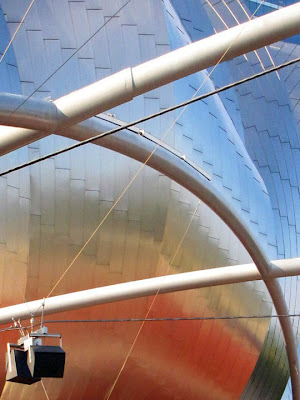 When I first discovered the joys of Photoshop, I took pride in only altering my images when the prints I had gotten from my local developer didn't seem to be true to what I had seen. But then, as I grew more proficient with the software, I began "removing unsightly blemishes" -- telephone wires and the like -- things that seemed to interfere with the overall impact of the work.
When I first discovered the joys of Photoshop, I took pride in only altering my images when the prints I had gotten from my local developer didn't seem to be true to what I had seen. But then, as I grew more proficient with the software, I began "removing unsightly blemishes" -- telephone wires and the like -- things that seemed to interfere with the overall impact of the work.Other artists helped me begin to see the artistic potential in my basic images. My friend Ann Jones taught me to crop "for the good parts." My friend David Warren patiently explained layers to me, and I began, first to see how basic flaws in contrast and color could be overcome, and then how double exposures could be intentionally created.
But the tipping point came when my gallery invited me to be part of a Manipulated Image show. I confess I didn't do much for the show; mostly submitted things I had played around with in earlier days when I was still experimenting. But the idea of the show planted a seed, and eventually -- just about the time when cellphones with cameras were starting to proliferate and EVERYBODY was doing photography, I came to see that the original image could itself be a seed; that I could play with it and tweak it until it said something about my own vision of the world and what I see.
 It's a bit like a sculptor with a stone; paring away what is unnecessary to reveal what lies beneath. Which is how a picture like the one shown above can be created out of the original image shown at left: some cropping, a little stretching, a heightening of color, lights and darks...
It's a bit like a sculptor with a stone; paring away what is unnecessary to reveal what lies beneath. Which is how a picture like the one shown above can be created out of the original image shown at left: some cropping, a little stretching, a heightening of color, lights and darks...Perhaps we, too, are works in progress. Perhaps, even as a potter works with clay or a photographer works with a basic image, our Creator works with us, over the course of a lifetime -- sometimes adding layers of meaning and experience; contrast and intensity; color, dark and light; sometimes stretching us, or pruning us -- working with and through us to express some Larger Vision.
Somehow that makes it easier to handle the inevitability of change and this constantly evolving existence. And I'm realizing as I write that this whole idea is something I learned as a child in the Presbyterian Church; something about God as a weaver, life as a giant tapestry, predestination... I'm not always sure I believe that. But I do know there are times when I find the concept comforting.
1 comment:
I so enjoy how you never stop experiencing, never stop learning, from what you do and from what others show you, and then weave the lessons, which after all are God's lessons, into a clearer understanding and appreciation of how to be.
Post a Comment